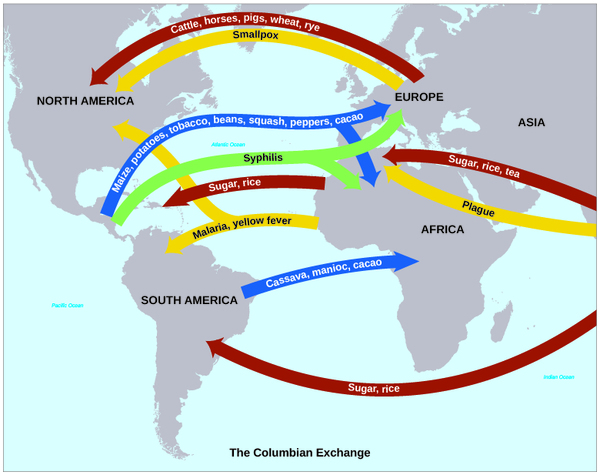| << Chapter < Page | Chapter >> Page > |
The 1500s and early 1600s also introduced the process of commodification to the New World. American silver, tobacco, and other items, which were used by native peoples for ritual purposes, became European commodities with a monetary value that could be bought and sold. Before the arrival of the Spanish, for example, the Inca people of the Andes consumed chicha , a corn beer, for ritual purposes only. When the Spanish discovered chicha, they bought and traded for it, turning it into a commodity instead of a ritual substance. Commodification thus recast native economies and spurred the process of early commercial capitalism. New World resources, from plants to animal pelts, held the promise of wealth for European imperial powers.
As Europeans traversed the Atlantic, they brought with them plants, animals, and diseases that changed lives and landscapes on both sides of the ocean. These two-way exchanges between the Americas and Europe/Africa are known collectively as the Columbian Exchange ( [link] ).

Of all the commodities in the Atlantic World, sugar proved to be the most important. Indeed, sugar carried the same economic importance as oil does today. European rivals raced to create sugar plantations in the Americas and fought wars for control of some of the best sugar production areas. Although refined sugar was available in the Old World, Europe’s harsher climate made sugarcane difficult to grow, and it was not plentiful. Columbus brought sugar to Hispaniola in 1493, and the new crop was growing there by the end of the 1490s. By the first decades of the 1500s, the Spanish were building sugar mills on the island. Over the next century of colonization, Caribbean islands and most other tropical areas became centers of sugar production.
Though of secondary importance to sugar, tobacco achieved great value for Europeans as a cash crop as well. Native peoples had been growing it for medicinal and ritual purposes for centuries before European contact, smoking it in pipes or powdering it to use as snuff. They believed tobacco could improve concentration and enhance wisdom. To some, its use meant achieving an entranced, altered, or divine state; entering a spiritual place.
Tobacco was unknown in Europe before 1492, and it carried a negative stigma at first. The early Spanish explorers considered natives’ use of tobacco to be proof of their savagery and, because of the fire and smoke produced in the consumption of tobacco, evidence of the Devil’s sway in the New World. Gradually, however, European colonists became accustomed to and even took up the habit of smoking, and they brought it across the Atlantic. As did the Indians, Europeans ascribed medicinal properties to tobacco, claiming that it could cure headaches and skin irritations. Even so, Europeans did not import tobacco in great quantities until the 1590s. At that time, it became the first truly global commodity; English, French, Dutch, Spanish, and Portuguese colonists all grew it for the world market.

Notification Switch
Would you like to follow the 'U.s. history' conversation and receive update notifications?